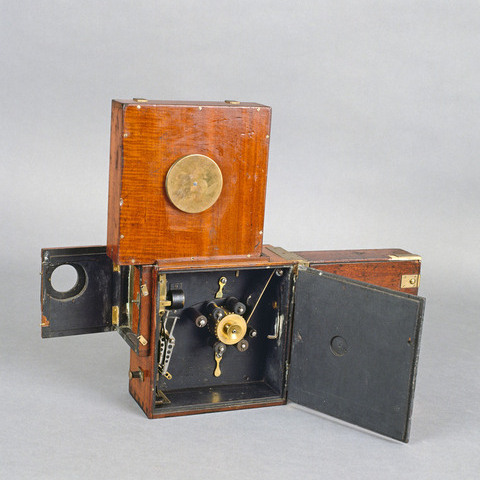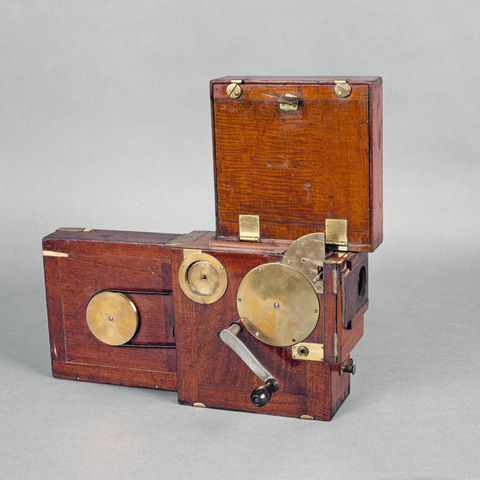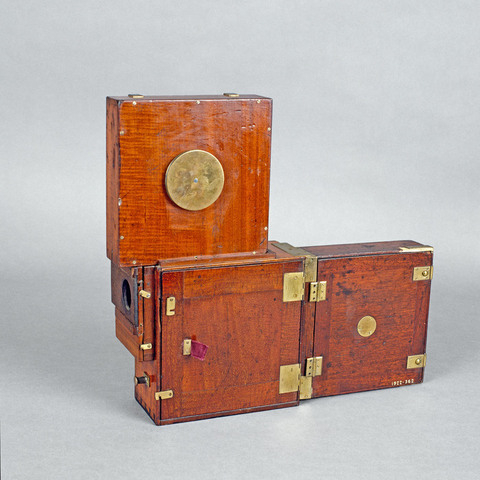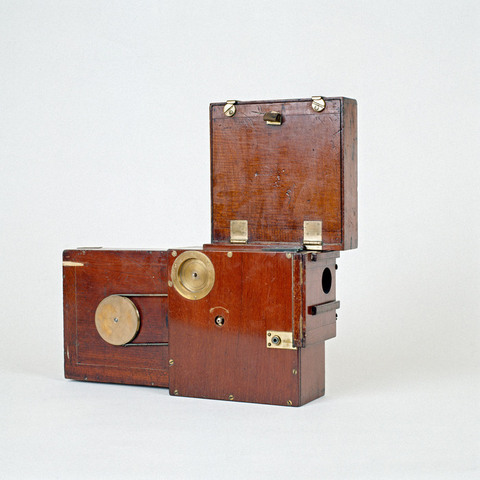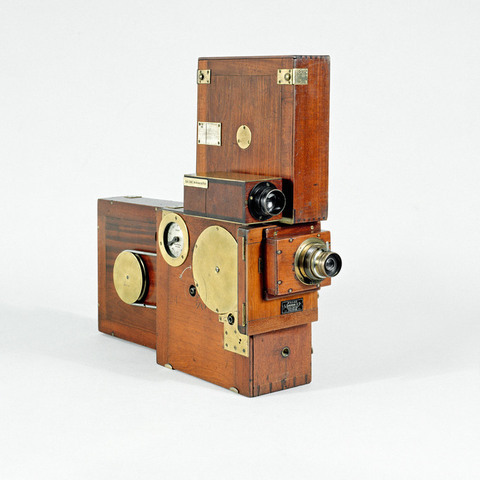Caméra film 35 mm
Fiche détaillée
Type de l'appareil
entraînement du film 35 mm par deux griffes montées sur lames flexibles ; came excentrique ; un débiteur denté ; peut servir aussi de tireuse ; deux magasins en bois pour 120 mètres ; compteur de pellicule ; manivelle
Auteurs
Prestwich John Alfred
Londres, 744 High Road, Tottenham
Fabricants
Prestwich, John Alfred - Prestwich Manufacturing Company
Londres, 744 High Road, Tottenham
Utilisateurs
Prestwich John Alfred
Londres, 744 High Road, Tottenham
Distributeurs
Clément et Gilmer
Paris, 8 et 10 rue de Malte
Prestwich, John Alfred - Prestwich Manufacturing Company
Londres, 744 High Road, Tottenham
Sujet du modèle
Informations non disponibles
Objectif
non d'origine (normalement, Dallmeyer Stigmat f : 5/75 mm)
Taille de l'objet
Ouvert :
Informations non disponibles
Fermé :
Longueur : 44.5 cm
Largeur : 16 cm
Hauteur : 40.5 cm
Diamètre :
Informations non disponibles
Taille de la boîte de transport
Informations non disponibles
Remarques
Gravé à l'intérieur : "Prestwich Manfg C°. Tottenham, London, Patent n° 1807". Voir double incomplet : AP-95- 1459. Caméra encore utilisée dans les années 1910 en Grande-Bretagne et en France, notamment dans les studios Gaumont. On la retrouve au catalogue anglais de Gaumont, The Chrono Demenÿ System Patent, Londres, c. 1909, p. 57 : "The Gaumont - Prestwich Camera Model N° 4 G".
"The claw or pin movement is entirely different from any other on the market, and has never been equalled for accuracy, simplicity and durability. The system of magazine change boxes, which are fitted to the camera render it very convenient ; the standard sizes contain 400 to 500 feet of film (according to thickness), which may be exposed in short lengths on different subjects. An indicator is fitted to the camera for showing the quantity in feet of film used, the number being discernible while the machine is being operated. [...] The spacing of the pictures is absolutely accurate at all speeds. The accuracy of the spacing does not depend on any gears cams, or delicate parts, and the accuracy is not impaired by constant use. All parts are beautiffuly made, the best gun metal and steel being used in construction, and case is of polished mahogany. The mechanism being fitted to a solid brass angle plate prevents any warping. The camera is therefore well suited for use in tropical climates. Used on most of the scientific expeditions and by the principal film makers throughout the world" (Illustrated Catalogue of the Prestwich, Specialities for Animated Photography, London, The Prestwich Manufacturing Co., s.d., p. 5).
"The latest form of camera, which may also serve as a printer : this machine is provided with a large view-finder and a recording-dial, which shows exactly how much film has been used ; the importance of this attachement cannot be over-estimated when long scenes are being photographed, or when several short episodes are taken on one long film, for it gives an absolute indication of how much film remains unused. The intermittent motion is a greatly improved guided claw, perfectly effective however high the rate of working, and it will be seen that feed and take-up are exactly balanced by driving the film from two sides of the same procket" (Henry Hopwood, Living pictures, their history, photo-production and practical working, London, The Optician & Photographic Trades review, 1899, p. 168-169).
"One of the most proficient makers of cinematographic equipment in England at this time was the Prestwich Manufacturing Company of 744 High Road, Tottenham, London. The cameras and projectors made by this firm begin to have a modern look about them which is not to be seen in those of any other English maker except R.W. Paul. In 1898 Prestwich is said to have had as many as nine different models on the market at the same time. Severeal of these must date back to the previous year, for so far as I can tell, no more than four new models were actually introduced during 1898. One of these was the Prestwich Cinematographic Camera & Printer, Model 4, which was constructed on an entirely different principile from the previous Prestwich cameras. Instead of the intermittent movement of the film being effected by an epicyclic sprocket, as formerly, this new model employed a claw mechanism. Furthermore, a single centraly-placed sprocket-wheel, moving continuously, acted as a combined feed and take-up sprocket, a function generally performed up till then, by an upper and lower sprocket-wheel. The camera was supplied with four films boxes each capable of holding 75 ft of film, and the complet outfit packed into a case measuring 6 1/2 x 8 1/2 inches. Film boxes for 500 ft of film could also be supplied, and either size box could be attached or detached in daylight. The camera was fitted with a Dallmeyer stigmatic lens of 3 inch focus, and there was a footage indicator. As a printer it was capable of printing 500 ft of film in one lenght. The claw mechanism employed in the n° 4, probably corresponds to the movement in J.A. Prestwich's patent of 18 August, 1898 (n° 17 831)" (John Barnes, Pioneers of the British Film, The Beginnings of the Cinema in England 1894-1901, volume 3, 1898 : The Rise of the Photoplay, London, Bishopsgate Press Ltd, 1983, p. 117-119).
Appareil vendu sous le nom "Vitagraphe n° 9" par Clément & Gilmer en 1902 : "Le Vitagraphe n° 9. Appareil photographique de professionnel. Modèle de haute précision avec objectif Anastigmat absolument garanti. De petit volume, il ne pèse que 4 kilos. Les magasins peuvent contenir de 120 à 150 mètres de film permettant de prendre au moins six bandes différentes ou d'un même sujet pendant au moins 10 mn. Le fonctionnement de cet appareil est irréprochable, la régularité des images est parfaite, donnant une projection stable. Un compteur indique le nombre d'images prises au cours de la marche de l'appareil. La construction tout en acier et cuivre est d'une solidité à toute épreuve et ne craint pas les climats tropicaux. Prix 700 francs. Pied spécial extra fort : 35 fr. Boîtes magasins de rechange, chaque 35 fr. Films négatives ou positives, 35 mm de largeur, perforation Edison, 4 trous par image, chaque longueur de 20 m, 20 fr. Grand viseur repéré avec soin pour la mise en plaque : 15 fr" (Maison fondé en 1860, Grande manufacture d'instruments de précision, Clément & Gilmer, Ingénieurs-Constructeurs, Catalogue n° 22, Paris, [Clément & Gilmer], s.d. [1902], p. 183).
Bibliographie
Illustrated Catalogue of the Prestwich, Specialities for Animated Photography, London, The Prestwich Manufacturing Co., s.d., 16 p.
Illustrated Catalogue of the Prestwich Specialities for Animated Photography, London, The Prestwich Manufacturing Co., s.d., 16 p.
Henry Hopwood, Living pictures, their history, photo-production and practical working, London, The Optician & Photographic Trades review, 1899, p. 169.
Maison fondé en 1860, Grande manufacture d'instruments de précision, Clément & Gilmer, Ingénieurs-Constructeurs, Catalogue n° 22, Paris, [Clément & Gilmer], s.d. [1902], p. 183.
John Barnes, Pioneers of the British Film, The Beginnings of the Cinema in England 1894-1901, volume 3, 1898 : The Rise of the Photoplay, London, Bishopsgate Press Ltd, 1983, p. 117-121.
